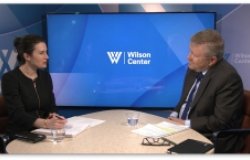IT Business Advocacy Roundtable Discussion
with Lucy Sanders , Chief Executive Officer and Co-Founder, National Center for Women and Information Technology; Peter Harsha, Director of Government Affairs, Computing Research Association; Cameron Wilson, Director of Public Policy, Association for Computing Machinery.
Overview
An event held to facilitate a candid discussion of pressing issues in the information technology (IT) sector took place on June 19th, 2008 at the Woodrow Wilson Center. Key topics discussed included the lack of participation in the IT workforce among women and minorities, the ebbing of public interest in IT professions, the decline in government support for IT research, and the inadequate coverage of computer science in the K-12 curriculum.
This "IT Business Advocacy Roundtable" featured panelists Lucy Sanders, CEO and Co-founder of the National Center on Women in Information Technology (NCWIT), Peter Harsha, Director of Government Affairs at the Computing Research Association (CRA), and Cameron Wilson, Director of Public Policy Affairs at the Association of Computing Machinery (ACM).
The meeting began with presentations by the three panelists and was followed by open discussion, moderated by Kent Hughes, director of the STAGE program at the Woodrow Wilson International Center for Scholars.
Lucy Sanders of NCWIT emphasized the under-representation of women and general lack of diversity in the IT workforce. As the IT industry has grown over the past thirty years, the portion of women in the IT workforce has declined. Moreover, women hold less than five percent of all IT patents, and are underrepresented in the leadership roles of firms. Roots of this disparity are seen at the high school level, as the College Board reported that only fifteen percent of those who took the AP Computer Science Exam were female. Over the same time period, every other STEM discipline has seen the gender composition of its workforce become more balanced. Sanders argued that as IT job projections continue to grow and firms continue to see a shortage of workers, the industry must make a concerted effort to attract minorities and women. In addition to alleviating the shortage, Sanders postulated that a more diverse workforce may improve the performance of the industry as a whole, as studies have shown that diverse work groups produce better results than do homogenous ones.
Peter Harsha moved on to detail recent developments in the government institutions that support IT research. Harsha stressed that research and development (R&D) in the IT sector is crucial to the United States, because "IT drives our economy," and argued that more government support is needed. Innovation in the IT sector takes place through the intricate interplay of several important institutions, and the government support of R&D allows individuals from universities, research organizations, and the business world to exchange ideas and better coordinate their work. Harsha asserted that recent changes in the U.S. government's distribution of funds that support basic research could threaten IT innovation. Particularly troublesome is the decrease in funding for the Defense Advanced Research Projects Agency (DARPA), the agency which helped foster the development of several seminal IT innovations, including the Internet. Harsha reported that, due to the decline in DARPA funding, the National Science Foundation (NSF) is now responsible for the bulk of grant money awarded to universities conducting basic research in computer science. This has lead to an influx of research proposals submitted to the NSF and has overwhelmed its grant-review system, with the result that many promising projects are left unfunded.
Cameron Wilson shifted to discuss the state of computer science (CS) in the K-12 schools. He explained that a key leakage in the IT workforce pipeline comes from the inadequate preparation of students in primary and secondary schools. Guidance counselors often discourage high school students from considering IT careers, portraying them as unstable by pointing to the bursting of the dotcom bubble. More importantly, students do not receive adequate early exposure to computer science, as most grade school courses cover only rudimentary topics such as the use of software applications and the development of keyboarding skills. Computer science classes should be more rigorous, requiring the use and development of problem-solving skills and algorithmic thinking. Wilson argued that CS should be treated as a hard science, rather than an elective, and presented the ACM's proposals to effectively integrate computer science into the K-12 curriculum.
In the following roundtable dialogue, the participants first questioned why young students are generally uninterested in computer science. Many agreed that this could be partially explained by an image problem. Lucy Sanders remarked that most children perceive computing to be "nerdy, geeky." Susan Baker of the Information Technology Association of America (ITAA) suggested that the IT sector should take the opportunity to revamp its image and "re-brand" computer science. Chris Mustain of IBM added that one way to redefine computer science is to place more emphasis upon the human element of computing, that is, the improved human performance that stems from the implementation of computer systems. IBM, for example, calls their computer systems engineering division "Service Science."
Kent Hughes queried the roundtable about how to develop a K-12 computer science curriculum at the national level. Peter Harsha noted that the ACM has already developed a CS curriculum with various standards that emphasize important learning objectives. Wilson made the point that a significant barrier to the success of any national CS curriculum appears to be insufficient training for CS teachers. Both Lucy Sanders and Amy Burke of Texas Instruments Inc. stressed the importance of funding for teacher training programs. Several individuals emphasized that state and local action should not be neglected in the effort to both improve the CS curriculum nationally and to promote federal investment in IT research. Bobby Schnabel of NCWIT argued that K-12 curriculum is primarily a state discussion. Paul Redifer of Cisco echoed his comments, stating that, in general, there is not enough lobbying taking place at the state level.
Lucy Sanders remarked that many individual firms and organizations are attempting to address these important issues, but that greater coordination must take place among these related entities to achieve progress. Sylvia Palm of BAE Systems remarked that both private corporations and K-12 schools have immediate needs, and that better collaboration between these two groups could result in attracting more workers to the IT sector. John Palafoutas of the American Electronics Association (AEA) noted that German engineering firms have begun their workforce development recruitment as early as the kindergarten level.
In addition to more cooperation between business and the schools, stronger government support is needed – yet many participants in the discussion reported that policymakers have a general lack of awareness of the computer science discipline and the IT sector. Bill Kamela of Microsoft stressed that, in order to better inform the public and future policy, the entire IT sector should identify and get behind two or three central goals.
Drafted by Nick Mills, STAGE Program
Kent H. Hughes, Director, STAGE Program
Thank you for your interest in this event. Please send any feedback or questions to our Events staff.










